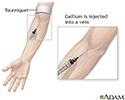Gallium scan
Liver gallium scan; Bony gallium scan
A gallium scan is a test to look for swelling (inflammation), infection, or cancer in the body. It uses a radioactive material called gallium and is a type of nuclear medicine exam.
A related test is a gallium scan of the lung.
How the Test is Performed
You will get gallium injected into your vein. Gallium is a radioactive material. The gallium travels through the bloodstream and collects in the bones and certain organs.
Your health care provider will tell you to return at a later time to be scanned. The scan will take place 6 to 48 hours after the gallium is injected. The test time depends on what condition your doctor is looking for. In some cases, people are scanned more than once.
You will lie on your back on the scanner table. A special camera detects where the gallium has gathered in the body.
You must lie still during the scan, which takes 30 to 60 minutes.
How to Prepare for the Test
Stool in the bowel can interfere with the test. You may need to take a laxative the night before you have the test. Or, you may get an enema 1 to 2 hours before the test. You may eat and drink liquids normally.
You will need to sign a consent form. You will need to take off all jewelry and metal objects before the test.
How the Test will Feel
You will feel a sharp prick when you get the injection. The site may be sore for a few minutes.
The hardest part of the scan is holding still. The scan itself is painless. The technician can help make you comfortable before the scan begins.
Why the Test is Performed
This test is rarely performed. It may be done to look for the cause of a fever that has lasted a few weeks without an explanation.
Normal Results
Gallium normally collects in bones, the liver, spleen, the large bowel, and breast tissue.
What Abnormal Results Mean
Gallium detected outside normal areas can be a sign of:
- Infection
- Inflammation
- Tumors, including Hodgkin disease or non-Hodgkin lymphoma
The test may be done to look for lung conditions such as:
- Primary pulmonary hypertension
- Pulmonary embolus
- Respiratory infections, most often Pneumocystis jirovecii pneumonia
- Sarcoidosis
- Scleroderma of the lung
- Tumors in the lung
Risks
There is a small risk for radiation exposure. This risk is less than that with x-rays or CT scans. Pregnant or nursing women and young children should avoid radiation exposure if at all possible.
Considerations
Not all cancers show up on a gallium scan. Areas of inflammation, such as recent surgical scars, may show up on the scan. However, they do not necessarily indicate an infection.
References
Contreras F, Perez J, Jose J. Imaging overview. In: Miller MD, Thompson SR, eds. DeLee, Drez, & Miller's Orthopaedic Sports Medicine. 5th ed. Philadelphia, PA: Elsevier; 2020:chap 7.
Harisinghani MG, Chen JW, Weissleder R. Imaging physics. In: Harisinghani MG, Chen JW, Weissleder R, eds. Primer of Diagnostic Imaging. 6th ed. Philadelphia, PA: Elsevier; 2019:chap 14.
Seabold JE, Palestro CJ, Brown ML, et al. Society of nuclear medicine procedure guideline for gallium scintigraphy in inflammation.The Society of Nuclear Medicine. Version 3.0. s3.amazonaws.com/rdcms-snmmi/files/production/public/docs/Gallium_Scintigraphy_in_Inflammation_v3.pdf. Approved June 2, 2004. Accessed September 30, 2022.
Squires JH, Narayanan S, Tadros S. Fundamentals of pediatric radiology. In: Zitelli BJ, McIntire SC, Nowalk AJ, Garrison J, eds. Zitelli and Davis' Atlas of Pediatric Physical Diagnosis. 8th ed. Philadelphia, PA: Elsevier; 2023:chap 25.
Review Date: 7/5/2022
Reviewed By: Jason Levy, MD, FSIR, Northside Radiology Associates, Atlanta, GA. Also reviewed by David C. Dugdale, MD, Medical Director, Brenda Conaway, Editorial Director, and the A.D.A.M. Editorial team.










